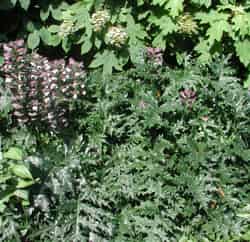Resource Library
Plant of the Week: Acanthus
The University of Arkansas System Division of Agriculture does not promote, support or recommend plants featured in "Plant of the Week." Please consult your local Extension office for plants suitable for your region.
Plant of the Week
Acanthus
Latin: Acanthus mollis
Just as some actors get type-cast as a hero or villain, a few plants take on identities of their own that forever define it in our consciousness.
The acanthus leaf, for example, is a widely used decorative feature found on everything from Corinthian columns to currency, yet few amongst us knows much about the true character of the plant.
Acanthus mollis, called Bear's Breech as a common name, is the headliner in its own family, the Acanthaceae. It's an evergreen herbaceous perennial native to southern Europe. In loose soils, it spreads quickly by underground roots forming large colonies. Individual plants grow from 3- to 5-feet tall when in bloom with leaves splaying out from a low rosette to an equal distance.
The smooth, rich, green leaves are deeply divided and sharply incised with lobes that end in a stout spine. The Latin name “acanthus” is taken from the Greek word for thorn. The basal leaves may be to 2 feet long and a foot wide.
Acanthus flowers appear in late spring or early summer on erect spikes. Individual flowers are an inch across, white to lavender and three lobed but covered on the top side by a spine-tipped, recurved bract in shades of lavender or greenish. Though the flowers are handsome and good subjects for drying, most grow acanthus for its bold, coarse foliage.
The Corinthian capital, the crowning member of a stone column crafted separately from the other pieces of the column, was used extensively in classical architecture and has been used in many neo-classic designs in Federal buildings throughout our nation. Its original design is credited to the 5th century BC Greek artist and architect Callimachus, one of the first to use intricate, hollowed-out design pieces as architectural detail.
According to Vitruvis, who wrote four centuries after Callimachus, the inspiration for the design came from seeing an acanthus leaf growing through a wicker basket placed atop a child's grave in Corinth. Roman architects used Corinthian capitals more than Greek architects.
Acanthus gets a mixed reception amongst gardeners. In areas with a Mediterranean climate such as California, acanthus is often considered an aggressive weed festooned with thorns. In areas with a proper winter it is less rambunctious and less prone to crowd out neighboring plants.
Members of the acanthus family tend to be moisture loving plants that wilt quickly and dramatically when they get dry. In most areas, except for those blessed with cool daytime temperatures, acanthus is best situated in partial shade at the back of the border. Or, if room is available, plant it in the shade garden along paths or streams where it can spread without concern of interfering with neighboring plants.
Acanthus can be grown from springtime divisions, 3-inch long root cuttings or seeds. Plant it in well drained but moist, reasonably fertile soil if you want it to spread. It's slow to establish in the garden and it's usually the second year before you know if it will make it or not.
It's winter hardy as far north as zone 5 with a wintertime protection of mulch. Many gardeners lose it over winter, so assume it lacks winter hardiness. This wintertime loss is more likely due to poor wintertime drainage than cold.
By: Gerald Klingaman, retired Extension Horticulturist - Ornamentals Extension News - March 9, 2007
The University of Arkansas System Division of Agriculture does not maintain lists of retail outlets where these plants can be purchased. Please check your local nursery or other retail outlets to ask about the availability of these plants for your growing area.
